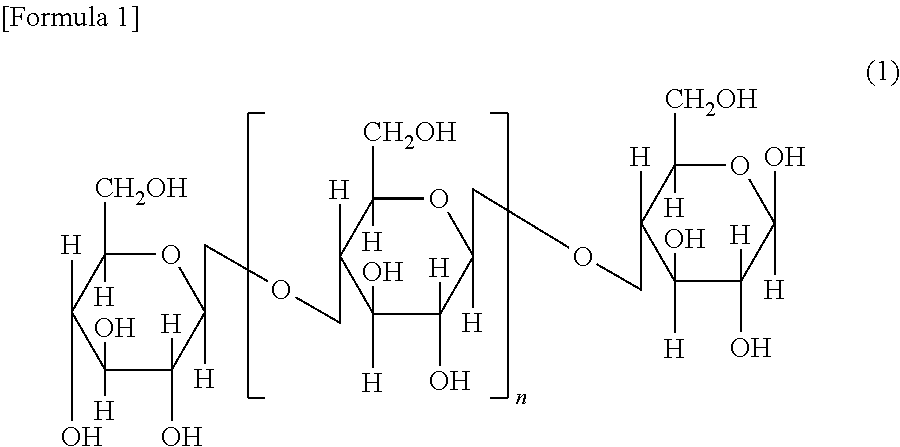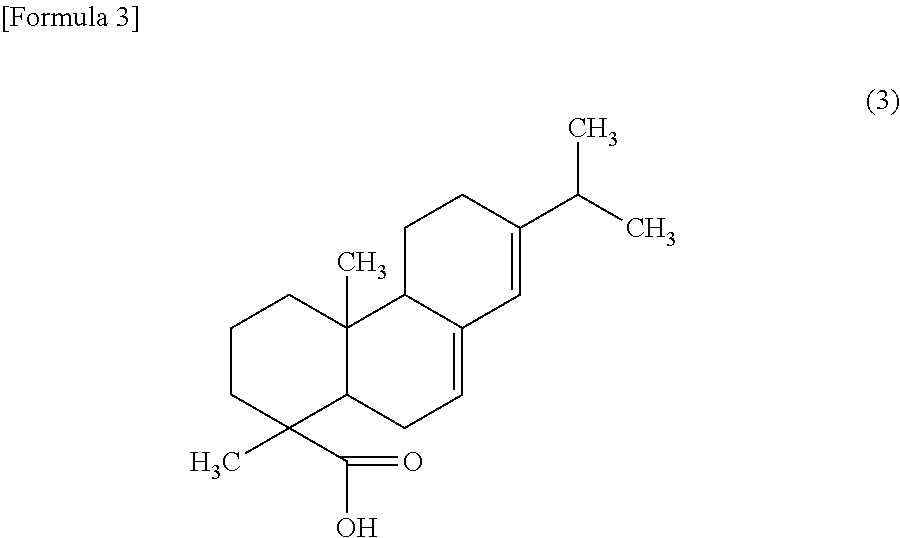Cellulose resin and method for producing the same
a technology of cellulose resin and cellulose resin, which is applied in the field of cellulose resin and a method for producing the same, can solve the problems of low water resistance, high water absorption, high cost, etc., and achieve the effects of improving thermoplasticity, mechanical characteristics and water resistance, and high utilization ratio of non-edible parts
- Summary
- Abstract
- Description
- Claims
- Application Information
AI Technical Summary
Benefits of technology
Problems solved by technology
Method used
Image
Examples
synthesis example 1
Cardanol Derivative 1 (Preparation of Chloridized and Succinic Acid-Modified Cardanol)
[0140]Hydrogenated cardanol (m-n-pentadecylphenol manufactured by ACROS Organics), in which an unsaturated bond(s) of the straight-chain hydrocarbon moiety of cardanol are hydrogenated, was used as a raw material. When the hydrogenated cardanol was measured by 1H-NMR (product name: AV-400, 400 MHz, manufactured by Bruker), no unsaturated bond was detected. Thus, it was confirmed that a hydrogenation rate is at least 90% by mole or more. The phenolic hydroxy group of the cardanol was reacted with succinic anhydride to add a carboxyl group to obtain carboxylated and hydrogenated cardanol. Next, the carboxyl group was converted into an acid chloride group by chloridizing it with oxalyl chloride to obtain chloridized and hydrogenated cardanol. More specifically, the chloridized and hydrogenated cardanol was prepared in accordance with the following procedure.
[0141]First, succinic anhydride (33 g (0.33 ...
synthesis example 2
Preparation of Abietic Acid Derivative
[0143]Hydrogenated abietic acid (trade name: Foral AX-E, manufactured by Eastman Chemical Company) was used as a raw material. When the hydrogenated abietic acid was measured by 1H-NMR (product name: AV-400, 400 MHz, manufactured by Bruker), no unsaturated bond was detected. Thus, it was confirmed that a hydrogenation rate was at least 90% by mole or more. The hydrogenated abietic acid (21 g (0.069 mol)) was dissolved in dehydrated chloroform (200 mL). To this, oxalyl chloride (13 g (0.11 mol)) and N,N-dimethylformamide (0.14 mL (1.8 mmol)) were added. The reaction solution was stirred at room temperature for 72 hours. Chloroform, excessive oxalyl chloride and N,N-dimethylformamide were distillated away under reduced pressure to obtain chloridized and hydrogenated abietic acid (22 g (0.068 mol)) in which a carboxyl group is converted into an acid chloride group.
synthesis example 3
Cardanol Derivative 2 (Preparation of Chloridized and Monochloroacetic Acid-Modified Cardanol)
[0144]Hydrogenated cardanol (m-n-pentadecylphenol manufactured by ACROS Organics), in which an unsaturated bond(s) of the straight-chain hydrocarbon moiety of cardanol are hydrogenated, was used as a raw material. The phenolic hydroxy group of the cardanol was reacted with monochloroacetic acid to add a carboxyl group to obtain carboxylated and hydrogenated cardanol. Next, the carboxyl group was converted into an acid chloride group by chloridizing it with oxalyl chloride to obtain chloridized and hydrogenated cardanol. More specifically, the chloridized and hydrogenated cardanol was prepared in accordance with the following procedure.
[0145]First, hydrogenated cardanol (80 g (0.26 mol)) was dissolved in methanol (120 mL). To this, an aqueous solution of sodium hydroxide (64 g (1.6 mol)) dissolved in distilled water (40 mL) was added. Thereafter, at room temperature, a solution of monochloro...
PUM
| Property | Measurement | Unit |
|---|---|---|
| hydrogen pressure | aaaaa | aaaaa |
| hydrogen pressure | aaaaa | aaaaa |
| hydrogen pressure | aaaaa | aaaaa |
Abstract
Description
Claims
Application Information
 Login to View More
Login to View More - R&D
- Intellectual Property
- Life Sciences
- Materials
- Tech Scout
- Unparalleled Data Quality
- Higher Quality Content
- 60% Fewer Hallucinations
Browse by: Latest US Patents, China's latest patents, Technical Efficacy Thesaurus, Application Domain, Technology Topic, Popular Technical Reports.
© 2025 PatSnap. All rights reserved.Legal|Privacy policy|Modern Slavery Act Transparency Statement|Sitemap|About US| Contact US: help@patsnap.com



